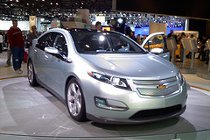EV growth optimistic
An electric car, a hybrid electric and a conventional sedan are the three finalists for the 2011 North American Car of the Year competition, showing some promise for a greener auto future.

 An electric car, a hybrid electric and a conventional sedan are the three finalists for the 2011 North American Car of the Year competition, showing some promise for a greener auto future.
An electric car, a hybrid electric and a conventional sedan are the three finalists for the 2011 North American Car of the Year competition, showing some promise for a greener auto future.
The winner will be announced next month at the North American International Auto Show in Detroit.
General Motors released the Chevrolet Volt, the first extended-range electric vehicle (EV) to be made for the mass market by one of the big US carmakers, at the same time as Nissan released the Nissan Leaf, an entirely electric hatchback. The two electric rivals began shipping out two weeks ago, to selected areas, including California, Texas, New York, New Jersey and Washington.
Both cars are being marketed as green alternatives, with Nissan's adverts involving a driver being hugged by a polar bear – at a time when the study, "Critical Materials Strategy", published on Wednesday (15th December 2010) suggested that radical emission cuts could protect polar bears.
Unlike initial experiences with electric cars in the 1990s – when GM ended up recalling and crushing the entire fleet – the Volt, first unveiled at the Detroit auto show four years ago, is seen as an important part of GM's comeback.
Early indications are encouraging. The car has received positive reviews from car magazines, and over 200,000 people have reportedly signed up for more information about the Volt on the company website.
The US Environmental Protection Agency (EPA) says the Volt can go 35 miles on electricity alone with a total range of 379 miles. GM contends it can go up to 50 miles on pure electric power. Nissan estimates the Leaf can go 99 miles on a charge, whilst the EPA's estimate is 73 miles.
The Volt's additional small petrol engine is seen as a safeguard against the distance it is possible to travel on a charged battery – the anxiety associated with 100 per cent EVs.
The price of the Volt starts at US$41,000, but sellers say the price is dictated by the US$15,000 cost of the battery pack. Customers in the US are, however, eligible for a US$7,300 tax credit, bringing down the price to about US$33,000. The Leaf sells for just under US$33,000 and also qualifies for a US$7,500 tax credit.
The state has allocated US$4.1 million to grant a US$5,000 clean-air rebate to buyers.
A recent survey showed that just one per cent of drivers prioritised low CO2 emissions over other features when buying a car, however the desirable cost of low carbon cars is what is attractive to consumers.
The survey, conducted for Carbuzz.co.uk, analysed the various factors involved when buying a vehicle in order to find out what motivated purchasers. Carbuzz found buyers were not motivated by cutting carbon emissions, yet the survey discovered that 16 per cent of respondents consider fuel economy the most important factor when choosing a new car.
"While many people may not in general be motivated to go low-carbon, there are some people who will do that, but the majority will go there because of the financial incentives," said Neil Wallis, Head of Communications for the Low Carbon Partnership, according to the energy saving trust website.
The concept of MPGe was created as a way to compare the efficiency of an EV to that of a gasoline-powered car, which the EPA says consumers indicated was important to them, however this makes comparison of electric cars difficult as they don't burn gasoline.
Either way, some US consumers have more choices, whilst further global choices appear set to arrive soon.
Toyota is testing a plug-in Prius that will reach the market in 2012 and Green Vehicles Inc. plans to produce the all-electric Triac, a two-seat commuter vehicle, at the former Firestone tire facility in Salinas.
"It's an exciting time to see these new plug-in vehicles coming to our county, heralding a new age of personal transportation," said Sharon Sarris, founder of the Monterey Bay Electric Vehicle Alliance.
According to the Electric Vehicle Alliance, local government, business, education and nonprofits in the tri-county region, where the new electric vehicles are being released, are getting ready for the new age.
With more people anticipated to be driving cars that run on electricity, more charging stations will be required, which will lead to jobs for electrical contractors. Although only limited new EVs are available for the next year, the green automobile industry looks to be growing.
Author: Marianna Keen | Climate Action
Image: LancerE | Flickr


_400_250_s_c1.png)


_400_250_80_s_c1.jpg)
